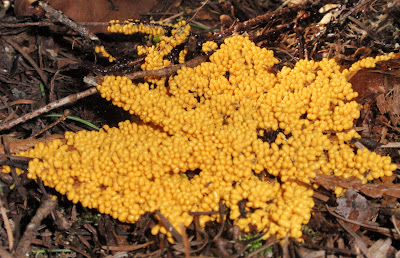Here is one that I found skulking around my pots this morning (he was moving too fast for my poor camera to get a good shot):
I first learned about these 3 years ago, almost to the day. I reprint here a 'Note' that I posted to my facebook friends entitled,
"In case we’re all dead in the morning, here’s what happened:"
May 7, 2010 at 11:32pmChildren playing outside in front yard while mom prunes monster rhododendron bushes. Children find a “caterpillar”, want to keep it as a pet, “Mommy isn’t it cute, it’s only a baby, it’s so tiny,” etc. Mommy looks at “caterpillar”, is pretty sure it’s something else, tries to convince kids to leave it alone (“It KNOWS where to find its OWN food”), finally gets frustrated with disobedient children and chucks “caterpillar” into underbrush so children can’t find it again. Mommy ushers children to back yard where they promptly find another one. Mommy thinks she convinces the kids to WATCH this one to see where it goes, only to find them holding and playing with it soon thereafter.
Mommy gets fed up and goes on the computer to find out what species it is. Turns out it’s a millipede:Harpaphe haydeniana to be exact. Oh, and by the way it is one of the species that secretes cyanide when it’s distressed. Mommy looks up to see the kids helping themselves to crackers, “DROP THE FOOD, GO WASH YOUR HANDS!!!” After a thorough hand-scrubbing session, mommy explains about “poison” and reads a first-hand account of a boy who got cyanide in his eyes after handling a millipede. Children duly impressed.
Son (age 4) later caught sneaking out back door with something behind his back. Lo and behold the millipede in a plastic container. Daughter (age 6) had snuck it into her room while mommy was researching – she still wanted it as a pet until the whole poison thing was revealed – and convinced her little brother to return the pet to its natural habitat.
We did take photos of “our” millipede, but the children appear to have hidden the camera.
I later found the camera and these were the photos we took at the time:
Places to learn a bit more about this species of millipede:
Wikipedia
Evergreen State College
The Bug Guide - information and photos







































